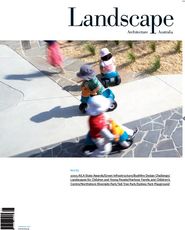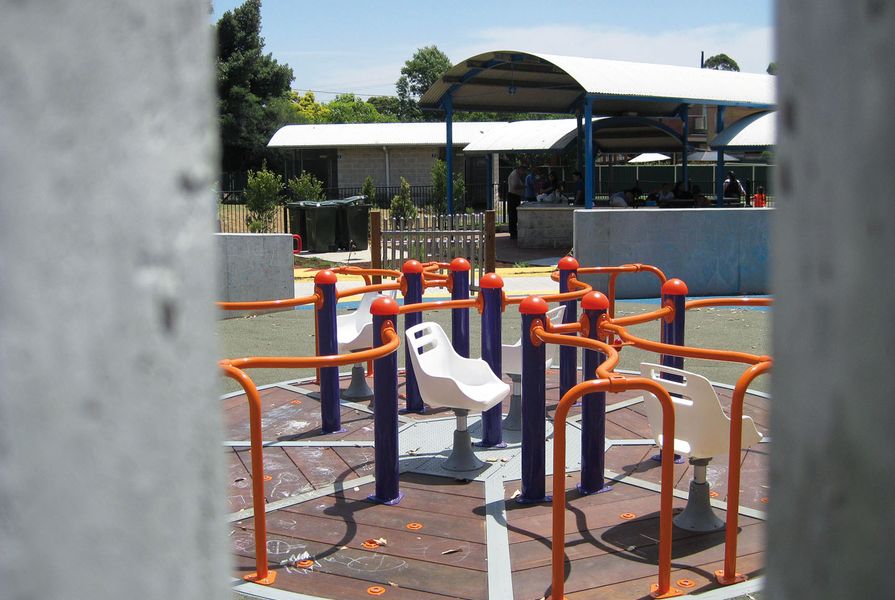Australia’s first truly all-abilities playground, Livvi’s Place at Timbrell Park in Sydney’s Five Dock, is designed for children with differing physical and neurological abilities.
Its purpose is to “cater for a broad range of special needs in a responsible and respectful manner including mobility, vision and hearing impairments as well as spectrum disorders, such as autism, to provide for both physical and emotional needs regardless of age or ability.” In doing so, Livvi’s Place aims to “dramatically reduce the barriers experienced by children with special needs, thereby giving them a level playing field for life.”
Livvi’s Place is the initiative of the Touched by Olivia Foundation, which was established by John and Justine Perkins in 2006 after their child died of cancer. The foundation is their way of “bringing Olivia’s touch to others by creating a positive change to the lives and futures of other children.” The foundation approached the City of Canada Bay (CCB) in Sydney with a brief to initiate the development of such playgrounds throughout Australia, and CCB and the foundation were joined by Leighton Contractors to form a community partnership model.
Ben Richards, CCB’s landscape architect, explained some of the key premises for the playground’s program. Research has shown that “kids develop biases by the age of five so it is important to develop a playground where the able-bodied and others can play together in a structured environment. This increases their acceptance of people’s differences from a young age before these biases are embedded.” For similar reasons it is important that an all-abilities playground looks like a regular playground.
The playground includes a sensory maze and a snakes and ladders activity path, alongside modified playground equipment.
Translating this into physical design is another matter. Autism, a neurological or spectrum disorder, is quite prevalent in our society, although less visible than many physical disorders. From the research done by the numerous people involved in the project, the issues relating to autism were narrowed down to two key aspects that needed addressing: socialization and dealing with unfamiliar spaces. Refining the criteria for these and then designing for them required an understanding of how autistic people experience these aspects. “When dealing with unfamiliar spaces, autistic children can experience extreme behavioural changes. They need safe zones where they can orientate themselves and manage any anxiety they may be feeling. These zones also provide a place of low activity where they can take time-out from the high energy activity occurring around them,” explained Richards.
At Livvi’s Place this research is expressed as a wide path with yellow lines on either side – or safe zone. Richards explained that children can use this zone to familiarize themselves and to decide whether they will engage with a particular piece of equipment. The paths have also been designed so that expansion and tool joints are virtually invisible. There are no drains or utility pits on the path as any inconsistency in the appearance of the ground plane may affect the integrity of that particular safe zone and cause a behavioural reaction.
Each piece of play equipment caters for one activity only. This allows for each child to make an accurate assessment of the level of socialization needed and thus whether they wish to engage with it. “The ground plane is organized with visual cues with adequate space between each activity. This also allows for visually impaired users to negotiate between pieces of equipment without a carer assisting them,” explained Richards. Each fall zone is differentiated by colour.
It is far easier to design for physical disabilities than for spectrum disorders and at Livvi’s Place the physical has been addressed in many ways, in particular through modifying equipment.These modifications also allow for carers to be with the children as they engage with the equipment, thereby providing emotional and physical support.
These are just some of the ways in which the all-abilities criteria have been translated into design, while other aspects reflect the intentions of the Touched by Olivia Foundation. It is CCB’s intention to monitor the playground for how (and how much) the children use the space. Some aspects may be replicated in other playgrounds and equipment modified. Even if some more able-bodied children may not be so excited about it, it must be an extraordinary opportunity for those who don’t take playgrounds for granted.
Credits
- Project
- Livvi's Place
- Project Team
- Ben Richards (CIty OF Canada Bay), Wendy Shepherd (Macquarie University’s Mia Mia Child Care Centre), Janet Robertson (Macquarie University’s Mia Mia Child Care Centre), Kate Fraser (KidSafe), Rebecca Hartly (Play Safe), Libby Creelman (Lucas Gardens Special School), Jo-Anne Gardiner (Lucas Gardens Special School), Ann Roberts (Lucas Gardens Special School), Fiona Robbé (Fiona Robbé Landscape Architects), Kate Bishop (Play For All), Margo Ward (Kids Xpress)
- Consultants
-
Detailed design
Taylor Thomson Whitting (TTW), Leighton Contractors, Alltech Electrics, Nisbet & Durney
Founding partner Touched By Olivia Foundation, City of Canada Bay, Leighton Contractors
- Site Details
-
Location
Timbrell Park,
Five Dock,
Sydney,
NSW,
Australia
- Project Details
-
Status
Built
Category Landscape / urban
Type Public / civic
Source

Discussion
Published online: 1 Feb 2010
Words:
Tempe MacGowan
Issue
Landscape Architecture Australia, February 2010


















